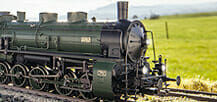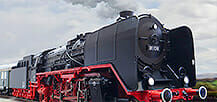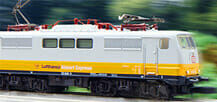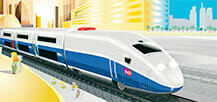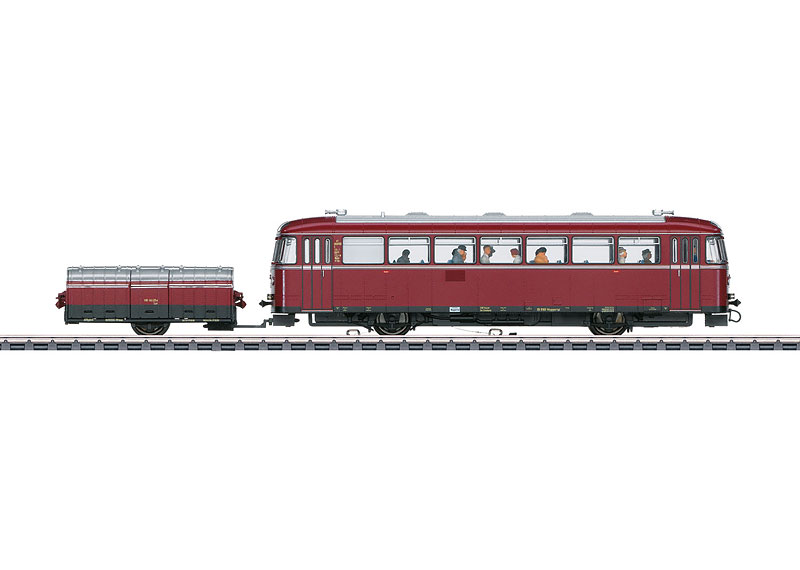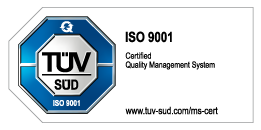VT 95.9 Rail Bus with a VB 141.2 Single-Axle Trailer Car
Prototype: German Federal Railroad (DB) class VT 95.9 rail bus motor car with a class VB 141.2 single-axle trailer car. Road number VT 95 9165 for the motor car from the first production series, in the original crimson paint scheme, with a skylight window above the engineer's stand. Road number VB 141 254 for the single-axle trailer car in a crimson paint scheme, with marker lights. The rail bus and trailer car look as they did around 1955/56.
Most Important Facts
Sound demo| Article No. | 39952 |
|---|---|
| Gauge / Design type | H0 / 1:87 |
| Era | III |
| Kind | Powered Rail Cars |
Highlights
- The single-axle trailer car is completely new tooling.
- Trailer car with 6 load doors that can be opened, includes 5 bicycles and several pieces of luggage already loaded.
- Red/white marker lights that change over on one end of the trailer car.
- mfx+ digital decoder in the motor car with extensive operations and sound functions for even more operating enjoyment in the Märklin "World of Operation".
- Motor car includes factory-installed interior lighting.
- Headlights on the motor car can be turned off separately at both ends.
- Factory-installed figure of motor man and numerous passengers.
-
Product description
Model: The rail bus has an mfx+ digital decoder and extensive sound and light functions. In addition to the usual sound functions, various conversations between passengers (dialog), sounds of the trailer car load doors being opened and closed, and sounds of the trailer car being loaded (background sounds) can also be activated by means of the function buttons. The rail bus motor car has controlled high-efficiency propulsion with a flywheel. 2 axles powered. Traction tires. The rail bus has factory-installed interior lighting. The rail bus has dual headlights and dual red marker lights that change over with the direction of travel, will work in conventional operation, and can be controlled digitally. The headlights at the Engineer's Stand 2 and 1 of the motor car can be turned off separately. Dual red marker lights on the single-axle trailer car are on and they change over with 2 white lights depending on the direction of the motor car. Maintenance-free warm white and red LEDs are used for the headlights, marker lights, and interior lighting. The rail bus units have a current-conducting drawbar coupling and a guide mechanism between them. The engineer's stands and the car's interiors in the motor car allow an open view through the windows. The motor car comes from the factory with a figure of a motor man and numerous passengers mounted in it. Brake hoses are included and can be mounted on the rail bus. All six load doors on the single-axle trailer car can be opened manually. All of the load doors can be folded back on themselves. The single-axle trailer car is loaded with 5 bicycles and several pieces of luggage. Two car supports are included for separate parking of the trailer car.
Length of the two-unit set 22 cm / 8-5/8".This model can be found in a DC version in the Trix H0 assortment under item number 22992.
Find more Märklin explanation videos on our YouTube Channel
Spare parts for our articles can be found here in our spare parts search.
The 39952 rail bus with a single-axle trailer car is being produced in 2016 in a one-time series only for Insider members.
-
Publications
- Special Imprint and Special Products - Fall New Items 2016 - Product programme 2016/2017
-
Prototype information
VT 95.9 Rail Bus with a VB 141.2 Single-Axle Trailer Car The first rail buses arose from the desire as early as the Thirties to develop lightweight, modest vehicles that made use of parts and assemblies from trucks and street buses. Soon after the end of World War II, the German Federal Railroad recognized that operations on many uneconomical branch lines could be maintained against the growing competition on the roads only through the extensive use of such rail buses. In 1949, the car builder Uerdingen was therefore awarded the contract to develop such a vehicle. Eleven prototypes with a Büssing motor (110 horsepower) installed below the floor were placed into operation between March and August of 1950. The similarity to street buses was unmistakable. The last and above all trend-setting prototype followed in November of 1950 with road number VT 95 912 (later VT 95 9112). Special approval from the transportation minister allowed the wheelbase on this rail bus to be lengthened to 6,000 mm / 19 feet 8 inches. Sufficient seating was now present thanks to the lengthening of the car body. An entire family of rail buses was done in the Fifties after thorough testing. A first series of 60 units of the single-motor VT 95 rolled off the assembly lines starting in 1952. The fixed wheelbase of 6,000 mm / 19 feet 8 inches was kept, but otherwise there were several changes. The ends were now ellipsoidal and skylight windows were installed above the engineer's stand. However, problems with the low motor performance of the rail buses soon became apparent in areas with many grades such that a trailer car (VB 142) could no longer be included with a motor car. The DB thus hit on the idea of developing a lightweight trailer car for transporting bicycles and luggage. Therefore, in 1951 an initial order for seven single-axle trailer cars (VB 141 200-206) was placed for the VT 95. Their construction was conceivably simple: The car body rested symmetrically on the brakeless wheel set and was equipped at both ends with a Scharfenberg coupler as well as a support for parking the car on a siding. The trailer car was 4.98 meters / 16 feet 2 inches long and weighed just 2 metric tons. There was room inside for a centrally arranged luggage area and eight bicycles. Three folding doors on each side allowed separate loading and unloading of the bicycle and luggage areas. After extensive testing of the first units, the DB ordered another 50 trailer cars of the same design. They were delivered in 1955 as road numbers VB 141 207-256. By 1955, the first series of the VT 95 was followed by another five units to make up a total of 496 rail busses. The installation of 130 and later 150 horsepower motors allowed the performance to be increased continuously. The skylights were done away with on these later series. Three-part folding doors on the ends of the cars allowed for fast boarding of passengers. The DB replaced steam locomotives for good on numerous branch lines with these rail buses, because operations could only be maintained in the first place on many lines thanks to the rail buses extremely economical operation. Unfortunately, the single-axle trailer cars did not turn out particularly well in daily use because the cumbersome and time-consuming loading and unloading at end stations required that the built-in supports be deployed each time in order to keep the car vertical. With increasing delivery of the two-motor VT 98 rail buses the need for baggage trailer cars quickly vanished and thus only three units were still around at the end of 1964. They were finally retired under the new class designation 941 on January 1, 1969. From the mid-Seventies on the single-motor rail buses (from 1968 on the class 795) were also retired in large numbers. In 1983 road number 795 445 was the last unit to be withdrawn from service. Numerous class 795 units were given a new lease on life in foreign countries and naturally on museum railroads in Germany. Road number 795 240 (former VT 95 9240) belongs to the DB's museum roster.
-
Digital Functions
Control Unit Mobile Station Mobile Station 2 Central Station 1/2 Central Station 3/2*
Mobile Station 2**Headlight(s) Interior lights Diesel locomotive op. sounds Warning Sound Direct control Sound of squealing brakes off Headlight(s): Cab2 End Conductor's Whistle Headlight(s): Cab1 End Doors Closing Rail Joints Station Announcements Dialog Dialog Dialog Sound of Couplers Engaging Surrounding Sounds 1 Surrounding Sounds 2 Surrounding Sounds 3 Dialog Surrounding sounds * New features of the Central Station 2 (Part No. 60213, 60214 or 60215) with the software update 4.2
** New features of the Mobile Station 2 (Part No. 60657/66955) with the Software Update 3.55
